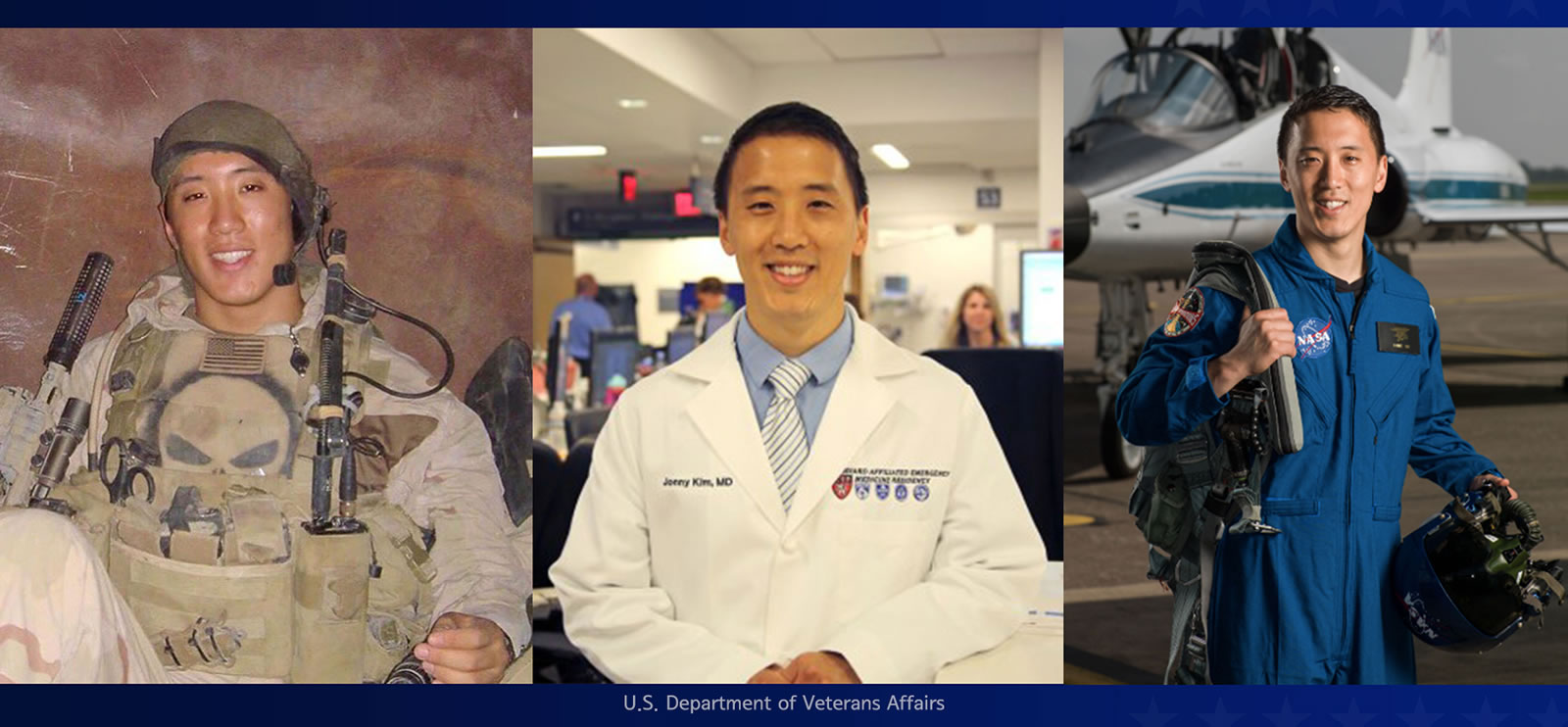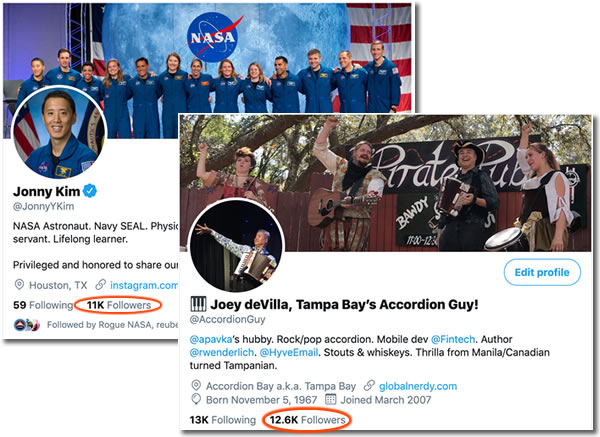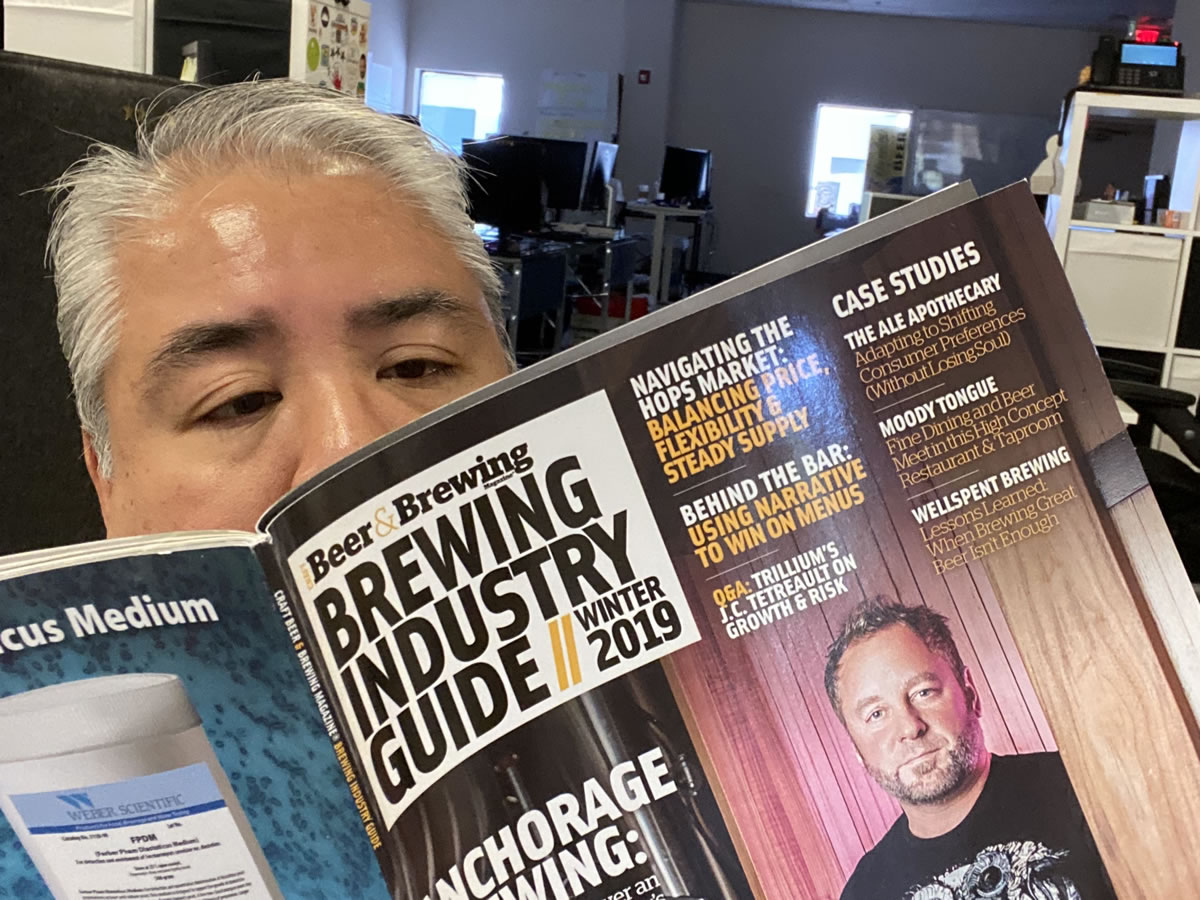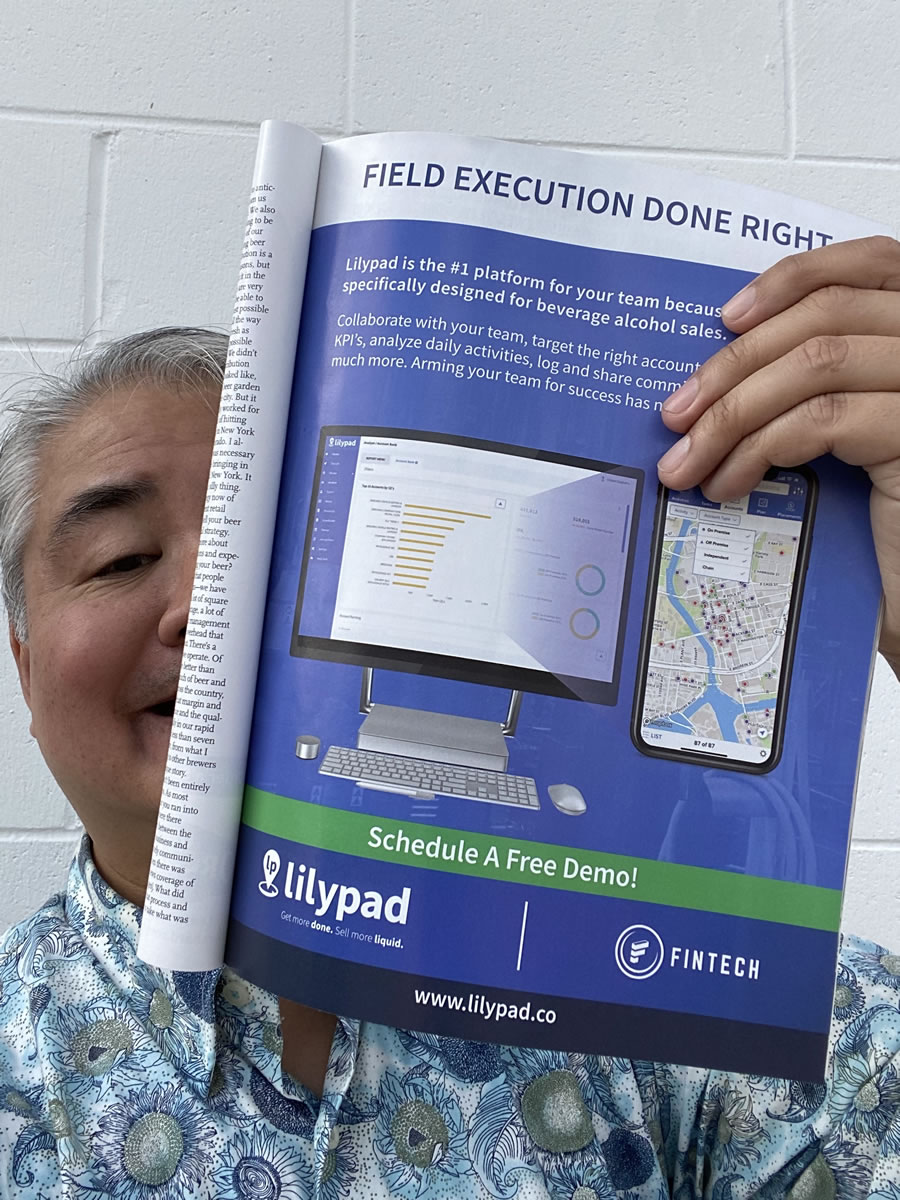
Photo by Joey deVilla. Tap to see at full size.
Someday, perhaps a decade from now, when we’re all looking back at how far the Tampa Bay area has come, we’ll look back and remark at the key role that Café con Tampa played. Every Friday from 8:00 a.m. to 9:00 a.m. in the Oxford Exchange’s Commerce Club, Tampa’s most active, engaged, involved, and well-dressed citizens gather to hear important topics given by interesting speakers while enjoying a delicious breakfast in beautiful surroundings.
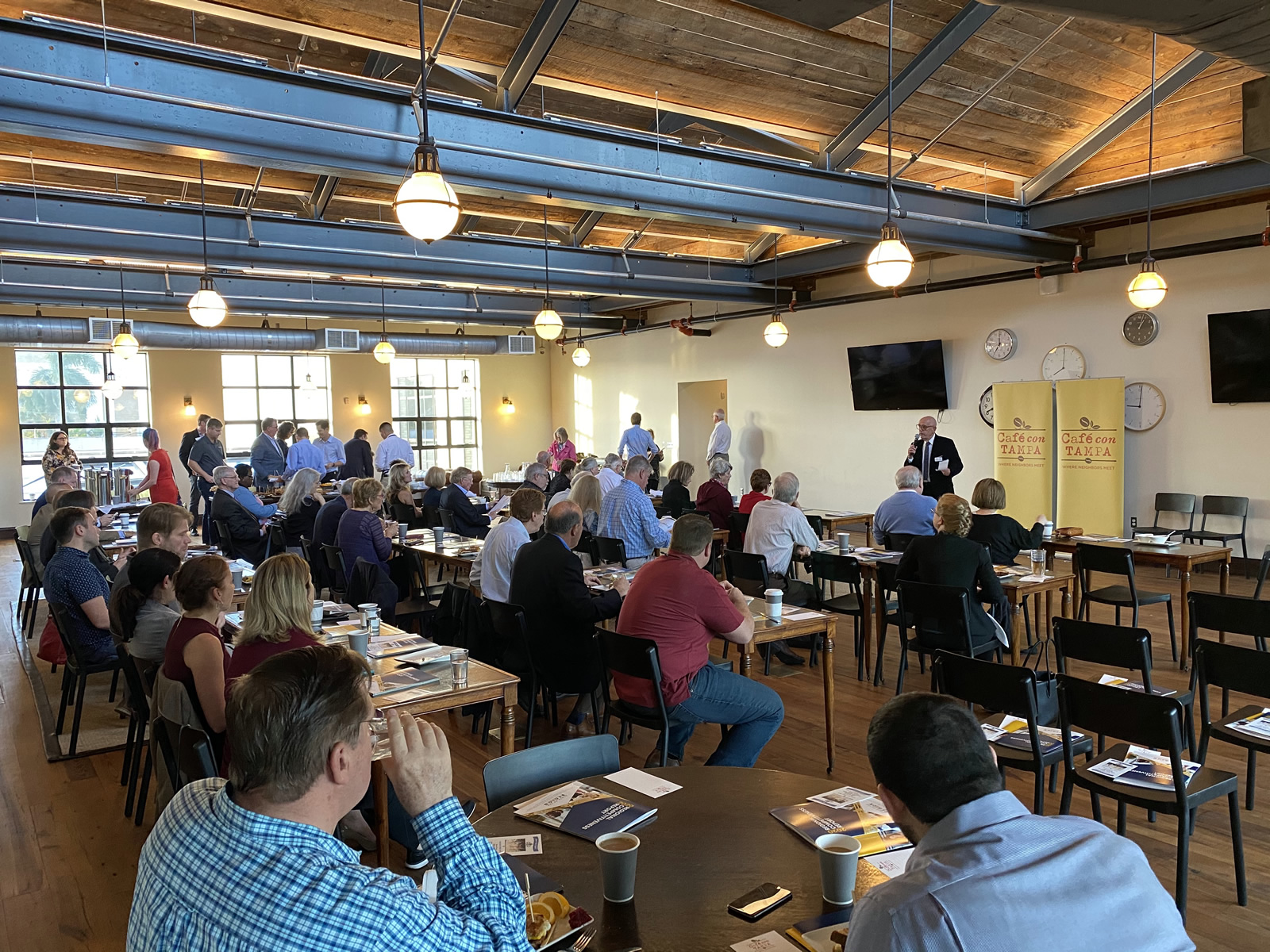
Photo by Joey deVilla. Tap to see at full size.
Last Friday’s edition of Café con Tampa’s guest speakers Rick Homans from the Tampa Bay Partnership and Moez Limayem, Dean of the USF Muma College of Business, who talked about the newly-released 2020 Regional Competitiveness Report. This is the third year this report was released, and it compares the Tampa Bay region to 19 similar metro areas in the U.S. using economic indicators.
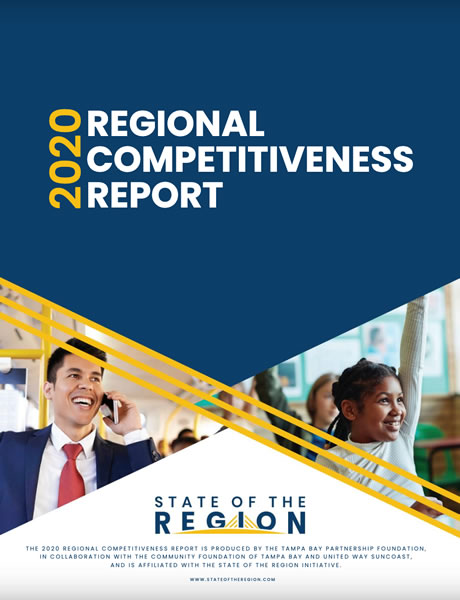
You can view the report online here.
The report paints a picture of an area with great potential and great disparity. In a meeting when the report was released the day before, Dave Sobush, director of policy and research at the Tampa Bay Partnership, had this to say:
“The Tampa Bay that many of us enjoy is not the Tampa Bay experienced by many of our neighbors, and while we should be proud of all that we’ve accomplished in recent years, we should also recognize that we can – and must – do better.”
Here are my photos and notes from the event:

Photo by Joey deVilla. Tap to see at full size.

Photo by Joey deVilla. Tap to see at full size.
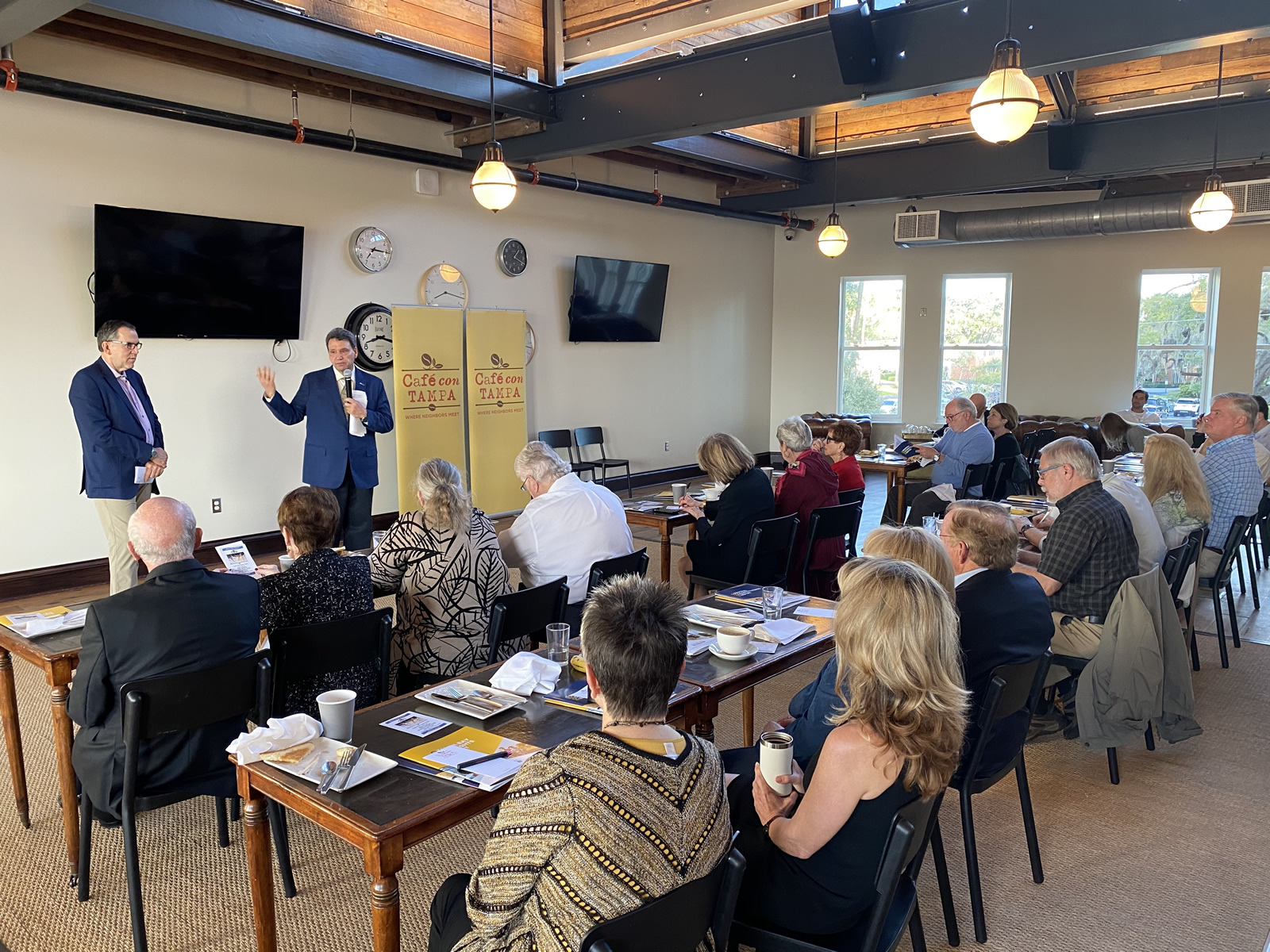
Photo by Joey deVilla. Tap to see at full size.
- The mantra: “What gets measured is what gets done.”
- When the Amazons of the world look at us to see if they want to set up shop here, they look at the hard data, and not the “fluffy stuff”.
- In the report, they paid attention to six specific “proven,” “unimpeachable” drivers of regional competitiveness, namely:
- Economic vitality
- Innovation
- Infrastructure
- Talent
- Civic quality
- Outcomes
They started by citing some statistics from the report.
First, the good news. Of the 20 regions in the comparison, Tampa Bay is number one in net migration!
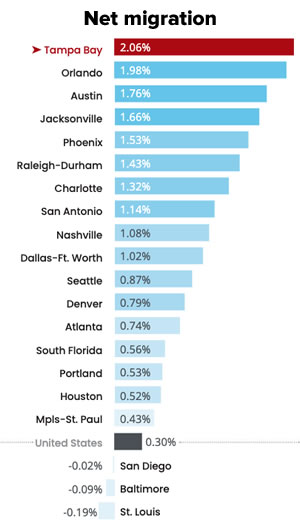
That’s one of the factors in Tampa Bay’s business establishment start rate…
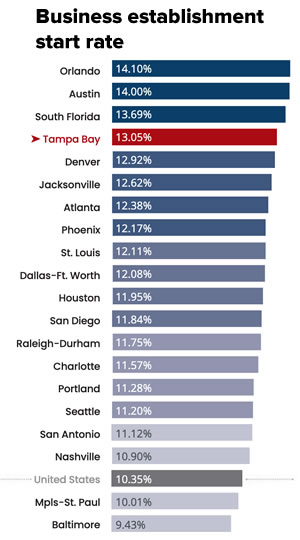
…as well as the share of its jobs which are in the “advanced industry” category:

Tampa Bay placed in the top 10 for 14 other indicators.
And then there’s the rest of the story: Tampa Bay placed at or near the bottom for 20 indicators, including percentage of working poor: 43% of Tampa Bay residents fall into working poor category.
Of the metros in the list, Tampa Bay placed second-last, with Orlando at the bottom:
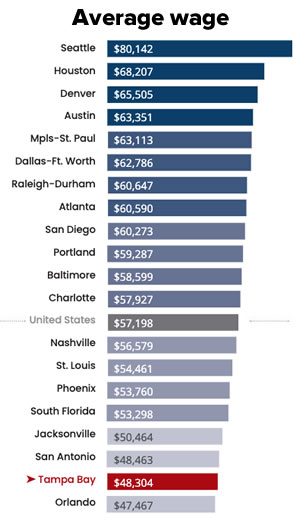
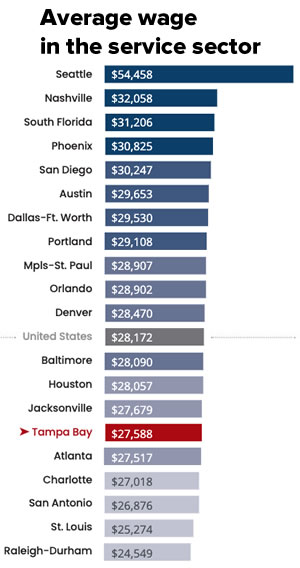
Here’s median household income: Tampa Bay is at the bottom of the 20 metros, with a mean of $55,701.
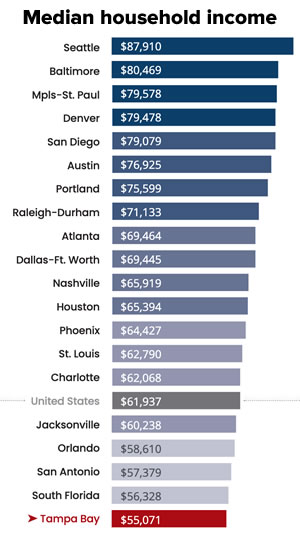
Tampa and Orlando also have the highest pedestrian and cyclist fatality rate, with Tampa being only slightly better than Orlando:
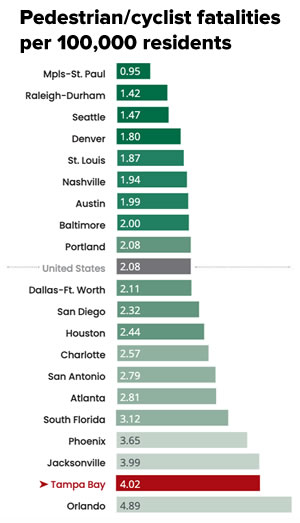
Tampa’s at the bottom of the list when it comes to availability of public transit, which is measured via revenue miles per capita, which measures the number of miles traveled by public transit vehicles during revenue service. If you live here — and especially if you moved here from a city with usable transit options — this is no surprise:

Educational attainment is another big economic indicator, and once again, Tampa is near the bottom:
We’re at the bottom in labor force participation rate, which is the percentage of the working-age population that’s either:
- employed, or
- unemployed and able to work and actively looking

When I first moved here, I got into a conversation with a taxi driver who’d immigrated here. He said “The best thing about this place is that I’m a genius next to the locals.” He may have had a point, based on these education achievement numbers:

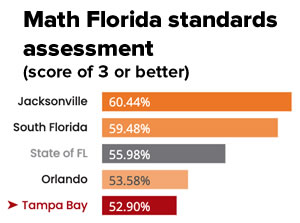
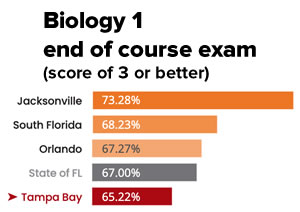
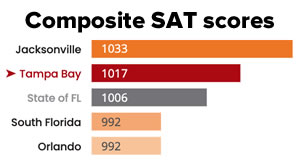
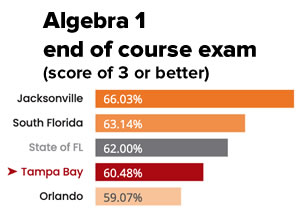
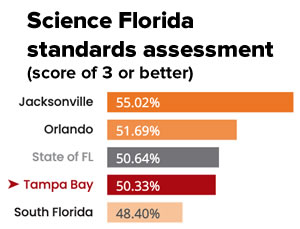
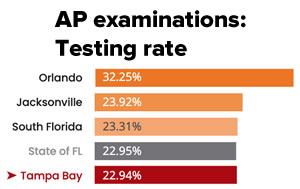

Another place where we’re rock-bottom: Per capital GRP — gross regional product, where you take the value of goods and services produced in the region and divide it by population:
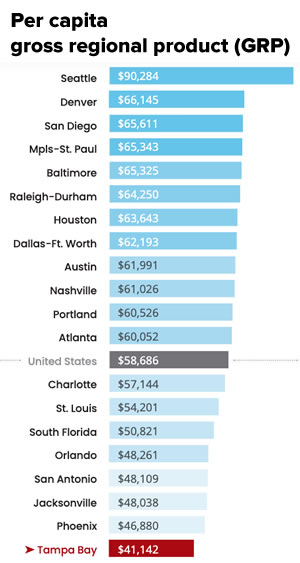
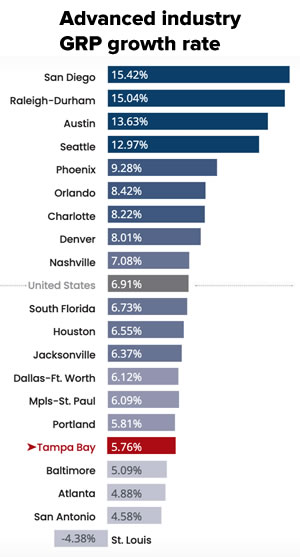
- These are major economic and structural issues
- Looking at where we stand in comparison to other regions, it’s tempting to say “Thank God for Miami, thank God for Orlando,” which place worse in some indicators
- The numbers get worse for women and people of color
- “Are we for taking from rich and giving to the poor? That’s not the idea”
- Economic mobility is the American dream
- Of the 20 million Americans born in the 80s, those born in the northeast and midwest are likely to be better off than their parents. However, if you were from the south or southeast, that’s considerably less likely to be the case.
- The southeast trend isn’t irreversible, nor is Tampa Bay doomed.
- Minneapolis was once where we were now, but they took steps to bring them to where they are today.
- You may be surprised to find out that a lot of research shows that the number one factor in upward economic mobility is the availability of public transit
Q & A
Q: We’re seeing wage growth in other parts of Florida outpacing our own. The state overall has 2 times Tampa’s wage growth, and in the case of Miami, it’s three times. We also have higher costs of housing. How do we fix this?
A: We’re not attracting the right level of jobs. We looked at signals and indicators in LinkedIn and Indeed.com, and for Tampa Bay, the opportunities and the path to growth are in work in the financial and IT sectors. We also have to resolve the problem that for the same jobs, people in Tampa Bay are paid less, even when you account for cost of living.
Q: So the report says that improving housing, education and public transport is necessary. Who’s doing that?
A: These are very important — especially having a reliable transit system. The economic situation in Minneapolis was bad until transit improved. We’re just part of a team, and the team that will deliver the necessary solutions has to be a bigger team than us. What we need to first do is realize that it’s okay to talk about our weaknesses — as long as we start addressing them. If we come back here every year and depress people, everyone will hate us!
Q: I’m trying to bring back the Urban League of Hillsborough County back. Will you help us?
A: Yes — we can talk about inequality or inequity. We need to look at zip code data vs. genetic data. Too many people are being left behind: there’s a 46% unemployment rate in certain neighborhoods in St. Pete. If we want to be among the best, no one in Tamp Bay should be left behind. We need to give people a chance regardless of race and zip code, and if we do that, we all win. This isn’t just a moral imperative, but a pragmatic one.
Q: How do you balance the effort to bring in companies vs. growing local companies? I’m thinking of ConnectWise, whose acquisition turned many employees into millionaires.
A: One reason ConnectWise was successful: USF alums! It’s important to keep our businesses here and give them the power to expand. We’re seeing increasing activity in the tech space at all levels, from large companies at the Synapse Summit to startups at Embarc Collective.
Q: The report covers a lot of things and the project of improving Tampa Bay may be too big. Can we focus on getting started with small improvements, such as raising teacher salaries, making the most of existing transit resources, and raising the salaries of the working poor?
A: We need a regional strategy. We’re just doing the research and making recommendations; we don’t have a plan for Tampa Bay. We’re trying to provide tools and data to formulate a plan. The good news is that there are a lot of things going on here in Tampa Bay to make things better. The bad news is that we’re fragmented and don’t talk to each other.
Q: What are solutions to our transportation issues? We got the sales tax to fund transit improvements approved — how do we use it now? How do we deal with the bridges, which are a choke point? Improvements of any sort could cost billions, and we still have people fighting the transit tax.
A: Right now, Tampa Bay is at 10 revenue miles per capita. In comparison, Seattle is at 30. We’d like to see it go up to at least 20, which would be a big deal. There are currently two valid projects for regional connectivity: Regional bus rapid transit using right of ways and shoulders, and CSX (a big challenge, but we need to look at it). We’re light years ahead of where we were 3 years ago — let’s develop the vision and plan to get the rest of the way. It will take time, but we need the effort.
Q: What are the dangers as we move the needle?
A: Cooperation between different groups and area, and sharing of expertise.
Q: Job growth comes largely from small businesses. Was there any attempt to separate small businesses in the report?
A: We looked at small businesses and entrepreneurs and counted them in. We found that for these businesses, early stage funding is the number one challenge. One of the warning signs in the report is that the rate of job growth is steadily declining.
Q: Is it wise to focus on elements of our transit system or focus on it as a whole?
A: It should be viewed as a whole, in order to better find ways to increase coverage and reliability. We have expertise and the data — we need to act! And yes, the ferry is a component of the system.
Q: Part of the problem is that when you talk to people from outside about Florida, they think of Miami and Disney, and that’s it. How do we solve this and get more people to think of Tampa Bay?
A: There’s the Global Tampa Bay initiative. We need it to send out a unified message, as the various counties in the region compete and send different signals. The gap between us and competitors is increasing, so we need to figure out what our regional brand is. There are good models to follow, both inside and outside Tampa Bay.

Café con Tampa is a weekly gathering where people interested in the issues that affect Tampa Bay and the world beyond meet to learn and share ideas with interesting, entertaining (and sometimes infuriating) guest speakers. It takes place every Friday between 8:00 and 9:00 a.m. in the wonderful setting of Oxford Exchange, a combination of restaurant, book store, gift shop, co-working space, design studio, event venue, and one of the best “third places” I’ve ever set foot in. It’s attended by an interesting audience that’s often a mix of movers and shakers from the worlds of arts, business, academia, and government, and put together by local heroes including Del Acosta and Bill Carlson, City Councilor and President of the communciations agency Tucker/Hall. Admission is $12.00, and it not only lets you into the event, but also gets you Oxford Exchange’s delicious breakfast spread. If you want to see interesting presentations and have great conversations with some of the area’s movers, shakers, and idea-makers — myself included — you should attend Café con Tampa!































